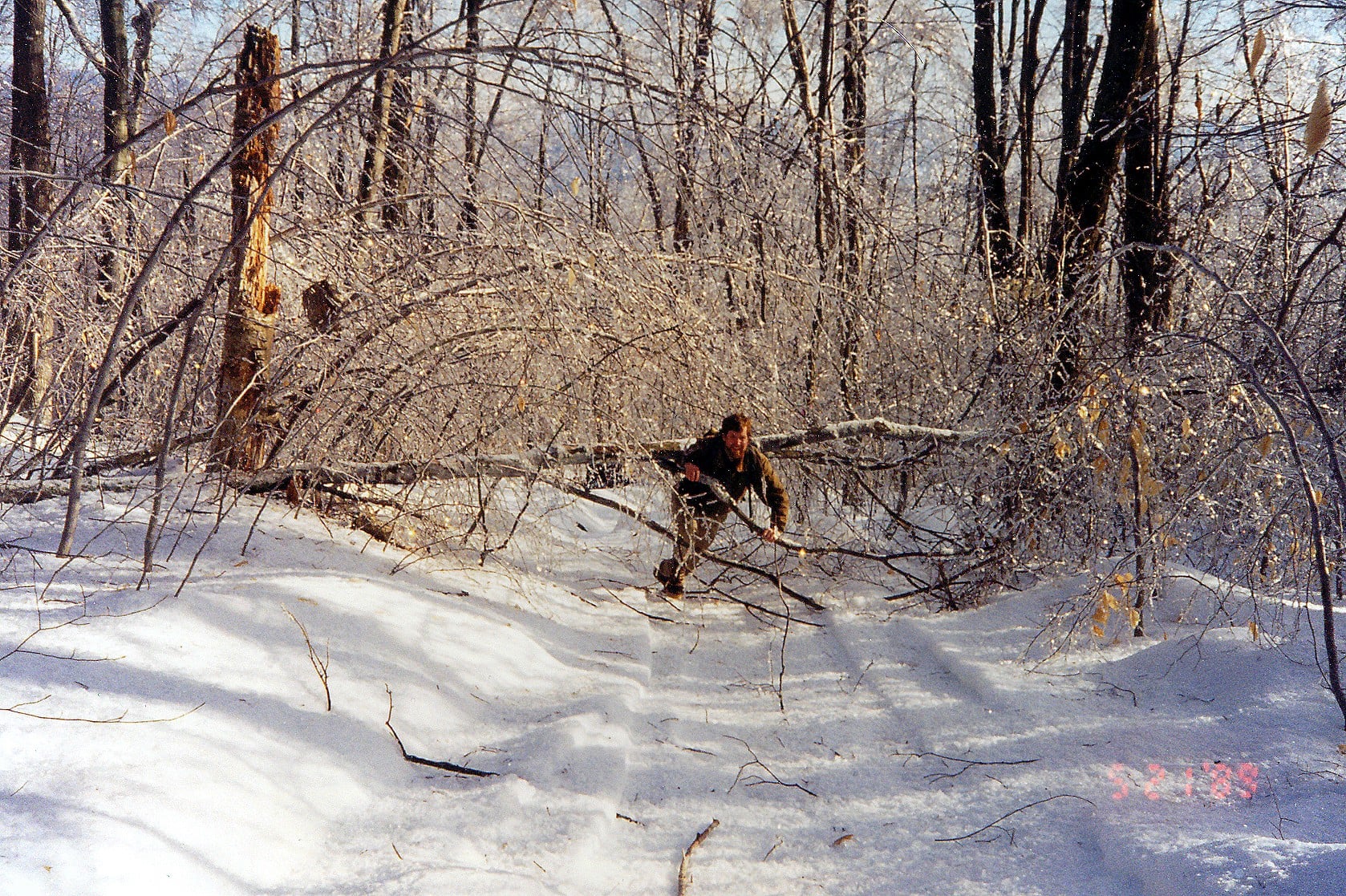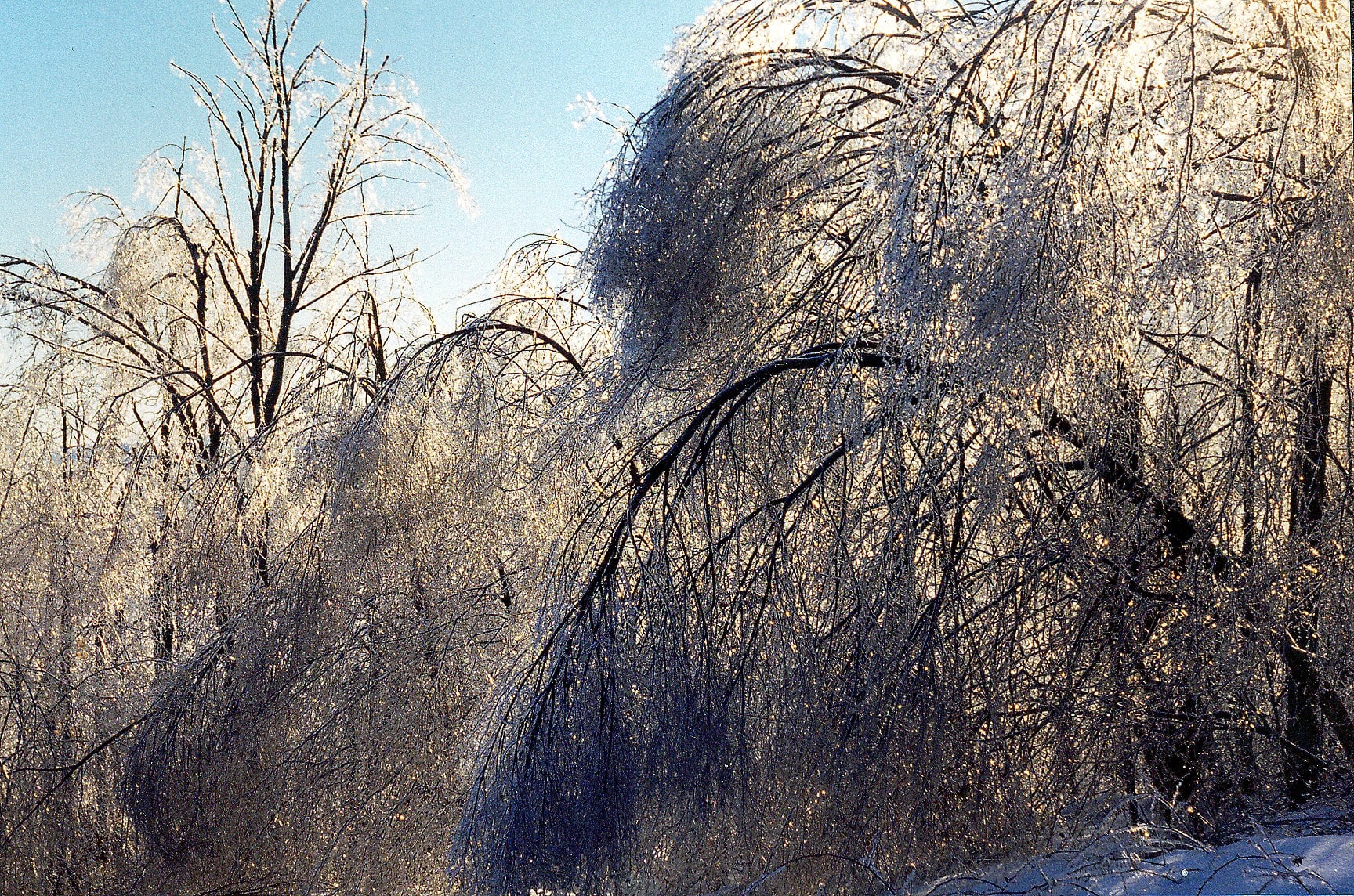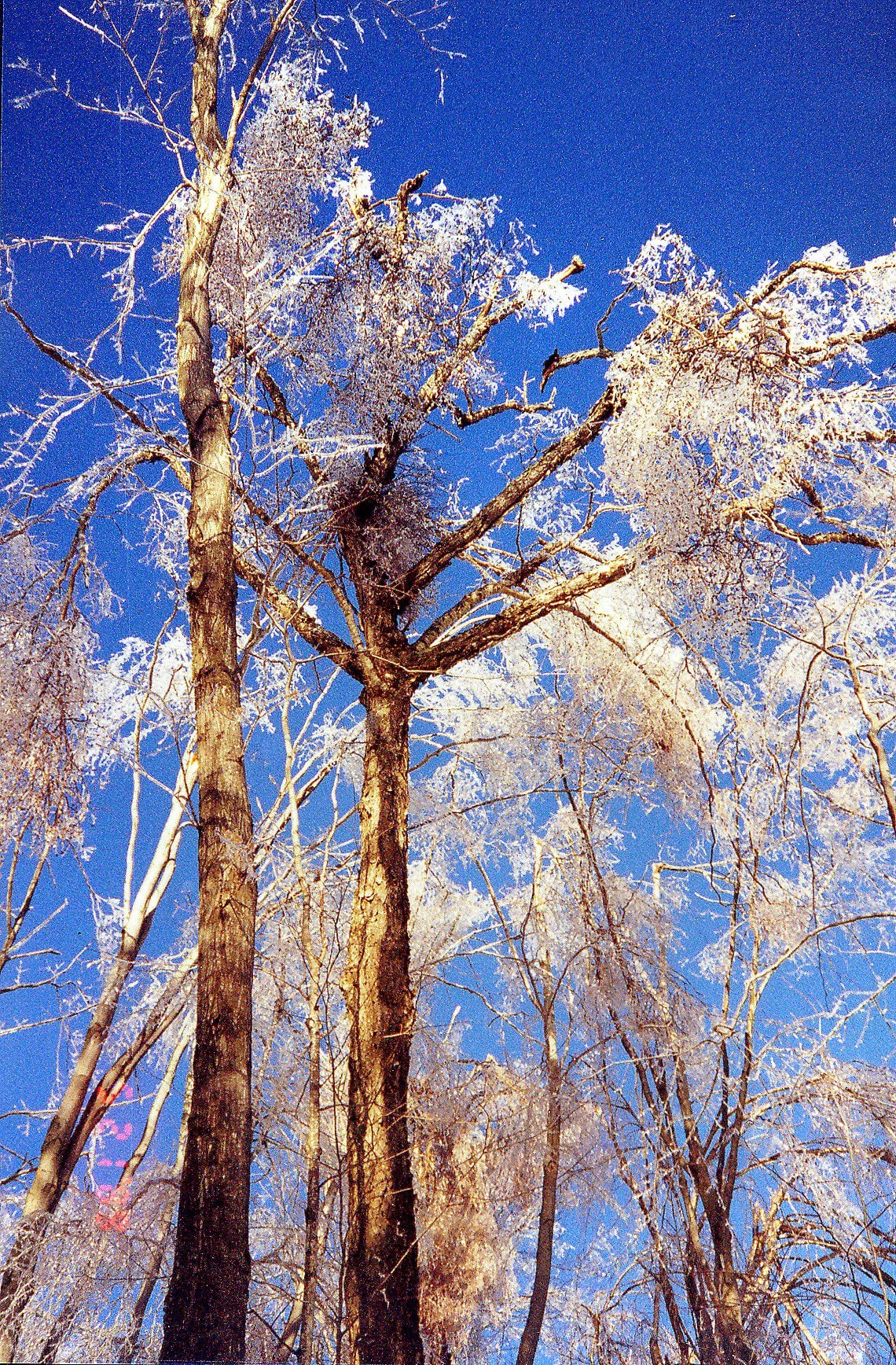It's not uncommon for technical staff at the Hubbard Brook Experimental Forest to encounter obstacles during New Hampshire's harsh winter months. Regular problems include water freezing at gaging stations, snow blanketing solar panels, and trees falling across the road.
But what greeted forestry technician Amey Bailey when she snowmobiled into the forest one Monday morning 20 years ago was far beyond any of the usual challenges. Beginning at an elevation of about 2,000 feet, the trees were sheathed in ice. The tinkling sounds of moving branches and the crashes of falling icicles filled the air, and downed debris littered the forest floor. "It was beautiful," Bailey says. "And horrible. The forest was just impenetrable."

Scott Bailey wrestles a downed tree in 1998. Photo: Jennifer Pett-Ridge
Between January 5 and 10, 1998, a powerful storm dumped more than 3 inches of freezing rain across parts of northern New York, Maine, Vermont, and New Hampshire—including the Hubbard Brook Experimental Forest—along with swaths of southeastern Canada. Power lines, transmission towers, trees, and small buildings collapsed under the weight of the ice, making it one of the worst natural disasters in Canadian history and wreaking havoc in the Northeastern U.S.
Fast forward 20 years, and Hubbard Brook scientists in 2018 know significantly more about the ecological effects of ice storms thanks to quick thinking during and immediately following the 1998 disaster. Their knowledge is critical. "Ice storms are one of the most devastating yet least understood extreme events," says Katharine Hayhoe, an atmospheric scientist at Texas Tech University and a Principal Investigator of a research project at Hubbard Brook.
"We're trying to understand how climate change might affect these storms in the future, but our historical records are woefully incomplete.
A broad “ice belt” that stretches from east Texas to New England is already prone to ice storms, as are much of Canada and parts of Europe and China. Some models suggest climate change may be giving these extreme weather events a boost. “That’s a big deal,” says Lindsey Rustad, Forest Service Team Lead at Hubbard Brook. “What happens if we have more of these, and more frequently?”

1998 Ice Storm at Hubbard Brook. Photo: Jennifer Pett-Ridge
On that fateful Monday morning 20 years ago, Bailey returned to Hubbard Brook headquarters to alert her colleagues that parts of the forest had been transformed into a brittle, brutal icescape. As residents of the Northeast were coping with mass power outages and billions of dollars worth of damage, researchers at Hubbard Brook were out in the field measuring ice thickness and quickly realizing that this massively destructive event also presented a huge opportunity for ecological study. With the aid of a National Science Foundation Small Grant for Exploratory Research, given to “projects whose results may enable our country to better mitigate, prepare for, respond to, and recover from catastrophic events,” they mobilized.
The research on the 1998 ice storm was mostly the product of hard work, but serendipity factored in, too. Ice storms are notoriously difficult to study. “You never know where they’re going to hit,” says Charles Driscoll, an environmental engineer at Syracuse University and a Principal Investigator at Hubbard Brook.
The 1998 ice storm happened to hit Hubbard Brook, a Long Term Ecological Research site with datasets dating back to the 1960s, making it uniquely poised to monitor natural disturbances. “Most times, ice storms are only recorded if they cause damage to infrastructure that’s been ensured, even though their impacts on forest ecosystems can be just as severe,” says Hayhoe. “That’s why the long-term record of ice storms at Hubbard Brook is so important. It provides us with an unparalleled perspective on these storms that is critical to understanding how and why they occur, and how they impact forests and ecosystems.”

1998 Ice Storm at Hubbard Brook. Photo: Jennifer Pett-Ridge
On top of the long-term record, in the winter of 1998 scientists had recently deployed a new suite of instrumentation into the forest in anticipation of a study the following summer. Those instruments—including lysimeters to measure soil solution chemistry, litterfall traps to measure plant production, and chambers to measure soil respiration—ended up doing double duty. They informed the study they were originally intended for while also adding a level of detail to the before-and-after measurements of the ice storm that would not have otherwise been possible. “Something really momentous happened, and we caught it,” Rustad says.
One of the team’s most important findings during the storm’s aftermath was a significant increase in the amount of nitrate in surface waters, likely due to decreased uptake by damaged plants. High nitrate levels in stream water can cause harmful algal blooms in estuaries and, at the extreme end, affect drinking water quality. Timothy Fahey, a forest ecologist at Cornell University and a Principal Investigator at Hubbard Brook, says there’s concern that an increase in events like this one could contribute to the cumulative effect of nitrogen pollution in coastal oceans.
The disappearance of as much as one-third of the forest canopy was a much more visually apparent response to the storm. It took about three years for the canopy to recover to pre-ice storm levels, but significant changes to canopy structure and species composition still remained eight years later.
The results of the Hubbard Brook research, along with a regional study of individual trees by Forest Service scientists Kevin Smith and Walter Shortle, suggest that trees can be remarkably resilient to ice storm damage if they’re healthy beforehand and if they have sufficient time to recover. But with forest pests on the rise and the potential for ice storms to hit more frequently, that’s a big “if.” John Campbell, a Forest Service Research Ecologist and a Principal Investigator at Hubbard Brook, notes that ice storms can also make healthy trees more vulnerable to pests and pathogens if they’re severely damaged.
Scientists are eager to learn more, but, as Driscoll says, “we can’t go and chase ice storms.” That’s why a team at Hubbard Brook have created their own. As valuable as the data from 1998 are, the novel Ice Storm Experiment allows ice storms to be studied under controlled conditions.
In the winters of 2016 and 2017, icing crews sprayed forest plots under subfreezing temperatures. Researchers carefully recorded the environmental conditions before their manmade storms struck, and they’ll monitor how the ecosystem responds over time. The investigators plan to develop global models to evaluate ice storm patterns in years to come, evaluate how trees cope with different frequencies and intensities of icing, and assess the short- and long-term effects on vegetation. “We’re creating this suite of icing experiments so that we can be ahead of the curve in understanding the forests of tomorrow, today,” says Driscoll.
Hubbard Brook’s analysis of the 1998 ice storm is “probably the most comprehensive postmortem of an ice storm anywhere in the world,” Rustad says. And with the Ice Storm Experiment adding new information all the time, more insights are yet to come.
